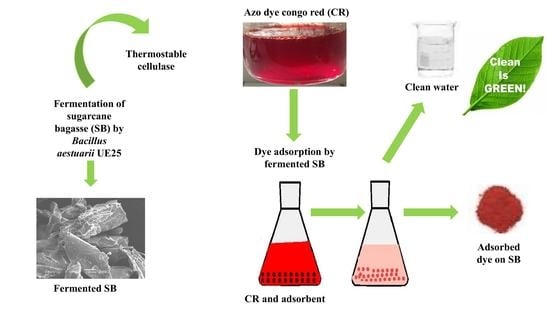Use of Ionic Liquid Pretreated and Fermented Sugarcane Bagasse as an Adsorbent for Congo Red Removal
Abstract
:1. Introduction
2. Materials and Methods
2.1. Lignin Removal from Sugarcane Bagasse
2.2. Fermentation of Pretreated Sugarcane Bagasse for Cellulose Degradtion
2.3. Enzyme Assay
2.4. Scanning Electron Microscopy and Fourier Transform Infrared (FTIR) Spectroscopy
2.5. Adsorption Experiments
2.6. Concentration of CR and Adsorption Capacity of SB
3. Results and Discussion
3.1. Pretreatment and Fermentation of Sugarcane Bagasse
3.2. Use of Untreated, Pretreated, and Fermented Sugarcane for Dye Removal
3.3. Effect of Initial Concentration of Dye
3.4. Adsorption Isotherm
3.5. Adsorption Kinetics
3.6. Thermodynamic Study
4. Conclusions
Supplementary Materials
Author Contributions
Funding
Institutional Review Board Statement
Informed Consent Statement
Data Availability Statement
Acknowledgments
Conflicts of Interest
References
- Robinson, T.; Chandran, B.; Nigam, P. Removal of dyes from a synthetic textile dye effluent by biosorption on apple pomace and wheat straw. Water Res. 2002, 36, 2824–2830. [Google Scholar] [CrossRef]
- Wong, S.; Ghafar, N.A.; Ngadi, N.; Razmi, F.A.; Inuwa, I.M.; Mat, R.; Amin, N.A.S. Effective removal of anionic textile dyes using adsorbent synthesized from coffee waste. Sci. Rep. 2020, 10, 2928. [Google Scholar] [CrossRef] [Green Version]
- Mall, I.D.; Srivastava, V.C.; Agarwal, N.K.; Mishra, I.M. Removal of congo red from aqueous solution by bagasse fly ash and activated carbon: Kinetic study and equilibrium isotherm analyses. Chemosphere 2005, 61, 492–501. [Google Scholar] [CrossRef] [PubMed]
- Tahir, H.; Sultan, M.; Akhtar, N.; Hameed, U.; Abid, T. Application of natural and modified sugar cane bagasse for the removal of dye from aqueous solution. J. Saudi Chem. Soc. 2016, 20, S115–S121. [Google Scholar] [CrossRef] [Green Version]
- Laraib, Q.; Shafique, M.; Jabeen, N.; Naz, S.A.; Nawaz, H.R.; Solangi, B.; Zubair, A.; Sohail, M. Luffa cylindrica immobilized with aspergillus terreus QMS-1: An efficient and cost-effective strategy for the removal of congo red using stirred tank reactor. Pol. J. Microbiol. 2020, 69, 193–203. [Google Scholar] [CrossRef]
- Calvete, T.; Lima, E.C.; Cardoso, N.F.; Vaghetti, J.C.P.; Dias, S.L.P.; Pavan, F.A. Application of carbon adsorbents prepared from Brazilian-pine fruit shell for the removal of reactive orange 16 from aqueous solution: Kinetic, equilibrium, and thermodynamic studies. J. Environ. Manag. 2010, 91, 1695–1706. [Google Scholar] [CrossRef]
- Ansari, I.; Ejaz, U.; Abideen, Z.; Gulzar, S.; Syed, M.N.; Liu, J.; Li, W.; Fu, P.; Sohail, M. Wild Halophytic Phragmites karka Biomass Saccharification by Bacterial Enzyme Cocktail. Front. Microbiol. 2021, 12, 714940. [Google Scholar] [CrossRef]
- Ejaz, U.; Sohail, M. Supporting role of lignin in immobilization of yeast on sugarcane bagasse for continuous pectinase production. J. Sci. Food Agric. 2020, 101, 1709–1714. [Google Scholar] [CrossRef]
- Jayapal, N.; Samanta, A.K.; Kolte, A.P.; Senani, S.; Sridhar, M.; Suresh, K.P.; Sampath, K.T. Value addition to sugarcane bagasse: Xylan extraction and its process optimization for xylooligosaccharides production. Ind. Crops Prod. 2013, 42, 14–24. [Google Scholar] [CrossRef]
- Khan, M.T.; Ejaz, U.; Sohail, M. Evaluation of Factors Affecting Saccharification of Sugarcane Bagasse Using Cellulase Preparation from a Thermophilic Strain of Brevibacillus. Curr. Microbiol. 2020, 77, 2422–2429. [Google Scholar] [CrossRef]
- Rashid, R.; Ejaz, U.; Sohail, M. Biomass to xylose. In Sustainable Bioconversion of Waste to Value Added Products; Springer: Cham, Switzerland, 2021; pp. 247–265. [Google Scholar]
- Ejaz, U.; Muhammad, S.; Ali, F.I.; Hashmi, I.A.; Sohail, M. Methyltrioctylammonium chloride mediated removal of lignin from sugarcane bagasse for themostable cellulase production. Int. J. Biol. Macromol. 2019, 140, 1064–1072. [Google Scholar] [CrossRef]
- Kumar, V.; Singh, D.; Sangwan, P.; Kaur Gill, P. Global market scenario of industrial enzymes. In Industrial Enzymes: Trends, Scope and Relevance; Nova Science Publishers: New York, NY, USA, 2014; pp. 173–196. ISBN 9781633213432. [Google Scholar]
- Ejaz, U.; Sohail, M.; Ghanemi, A. Cellulases: From Bioactivity to a Variety of Industrial Applications. Biomimetics 2021, 6, 44. [Google Scholar] [CrossRef]
- Ansari, M.; Zafar, U.; Ejaz, U.; Sohail, M.; Pirzada, A.; Aman, A. Comparison of composting of chemically treated and fermented sugarcane bagasse for zero-waste biorefinery. J. Mater. Cycles Waste Manag. 2021, 23, 911–921. [Google Scholar] [CrossRef]
- Docherty, K.M.; Dixon, J.K.; Kulpa, C.F. Biodegradability of imidazolium and pyridinium ionic liquids by an activated sludge microbial community. Biodegradation 2007, 18, 481–493. [Google Scholar] [CrossRef] [PubMed]
- Yoo, C.G.; Pu, Y.; Ragauskas, A.J. Ionic liquids: Promising green solvents for lignocellulosic biomass utilization. Curr. Opin. Green Sustain. Chem. 2017, 5, 5–11. [Google Scholar] [CrossRef]
- Bhat, A.H.; Khan, I.; Usmani, M.A.; Umapathi, R.; Al-Kindy, S.M.Z. Cellulose an ageless renewable green nanomaterial for medical applications: An overview of ionic liquids in extraction, separation and dissolution of cellulose. Int. J. Biol. Macromol. 2019, 129, 750–777. [Google Scholar] [CrossRef]
- Kanawade, S.M.; Gaikwad, R.W. Removal of Dyes from Dye Effluent by Using Sugarcane Bagasse Ash as an Adsorbent. Int. J. Chem. Eng. Appl. 2011. [Google Scholar] [CrossRef]
- Alene, A.N.; Abate, G.Y.; Habte, A.T. Bio-adsorption of Basic blue dye from aqueous solution onto raw and modified waste ash as economical alternative bio-adsorbent. J. Chem. 2020, 2020, 8746035. [Google Scholar] [CrossRef]
- Wang, L. Application of activated carbon derived from “waste” bamboo culms for the adsorption of azo disperse dye: Kinetic, equilibrium and thermodynamic studies. J. Environ. Manag. 2012, 102, 79–87. [Google Scholar] [CrossRef] [PubMed]
- El Haddad, M.; Slimani, R.; Mamouni, R.; ElAntri, S.; Lazar, S. Removal of two textile dyes from aqueous solutions onto calcined bones. J. Assoc. Arab Univ. Basic Appl. Sci. 2013, 14, 51–59. [Google Scholar] [CrossRef] [Green Version]
- Peláez-Cid, A.A.; Herrera-González, A.M.; Salazar-Villanueva, M.; Bautista-Hernández, A. Elimination of textile dyes using activated carbons prepared from vegetable residues and their characterization. J. Environ. Manag. 2016, 181, 269–278. [Google Scholar] [CrossRef]
- Sathishkumar, P.; Arulkumar, M.; Palvannan, T. Utilization of agro-industrial waste Jatropha curcas pods as an activated carbon for the adsorption of reactive dye Remazol Brilliant Blue R (RBBR). J. Clean. Prod. 2012, 22, 67–75. [Google Scholar] [CrossRef]
- Rangabhashiyam, S.; Anu, N.; Selvaraju, N. Sequestration of dye from textile industry wastewater using agricultural waste products as adsorbents. J. Environ. Chem. Eng. 2013, 1, 629–641. [Google Scholar] [CrossRef]
- Aljeboree, A.M.; Alshirifi, A.N.; Alkaim, A.F. Kinetics and equilibrium study for the adsorption of textile dyes on coconut shell activated carbon. Arab. J. Chem. 2017, 10, S3381–S3393. [Google Scholar] [CrossRef] [Green Version]
- Marrakchi, F.; Auta, M.; Khanday, W.A.; Hameed, B.H. High-surface-area and nitrogen-rich mesoporous carbon material from fishery waste for effective adsorption of methylene blue. Powder Technol. 2017, 321, 428–434. [Google Scholar] [CrossRef]
- Reffas, A.; Bernardet, V.; David, B.; Reinert, L.; Lehocine, M.B.; Dubois, M.; Batisse, N.; Duclaux, L. Carbons prepared from coffee grounds by H3PO4 activation: Characterization and adsorption of methylene blue and Nylosan Red N-2RBL. J. Hazard. Mater. 2010, 175, 779–788. [Google Scholar] [CrossRef] [PubMed]
- Borah, L.; Goswami, M.; Phukan, P. Adsorption of methylene blue and eosin yellow using porous carbon prepared from tea waste: Adsorption equilibrium, kinetics and thermodynamics study. J. Environ. Chem. Eng. 2015, 3, 1018–1028. [Google Scholar] [CrossRef]
- Chen, X.G.; Lv, S.S.; Liu, S.T.; Zhang, P.P.; Zhang, A.B.; Sun, J.; Ye, Y. Adsorption of Methylene Blue by Rice Hull Ash. Sep. Sci. Technol. 2012, 47, 147–156. [Google Scholar] [CrossRef]
- Ghosh, R.K.; Reddy, D.D. Tobacco stem ash as an adsorbent for removal of methylene blue from aqueous solution: Equilibrium, kinetics, and mechanism of adsorption. Water. Air. Soil Pollut. 2013, 224, 1–12. [Google Scholar] [CrossRef]
- Kushwaha, A.K.; Gupta, N.; Chattopadhyaya, M.C. Enhanced adsorption of methylene blue on modified silica gel: Equilibrium, kinetic, and thermodynamic studies. Desalin. Water Treat. 2014, 52, 4527–4537. [Google Scholar] [CrossRef]
- Tsai, W.T.; Hsien, K.J.; Hsu, H.C.; Lin, C.M.; Lin, K.Y.; Chiu, C.H. Utilization of ground eggshell waste as an adsorbent for the removal of dyes from aqueous solution. Bioresour. Technol. 2008, 99, 1623–1629. [Google Scholar] [CrossRef] [PubMed]
- Mandels, M.; Weber, J. The Production of Cellulases; ACS Publications: Washington, DC, USA, 1969; pp. 391–414. [Google Scholar]
- Miller, G.L. Use of Dinitrosalicylic Acid Reagent for Determination of Reducing Sugar. Anal. Chem. 1959, 31, 426–428. [Google Scholar] [CrossRef]
- Pandey, A.; Soccol, C.R.; Nigam, P.; Soccol, V.T. Biotechnological potential of agro-industrial residues. I: Sugarcane bagasse. Bioresour. Technol. 2000, 74, 69–80. [Google Scholar] [CrossRef]
- Ejaz, U.; Muhammad, S.; Hashmi, I.A.; Ali, F.I.; Sohail, M. Utilization of methyltrioctylammonium chloride as new ionic liquid in pretreatment of sugarcane bagasse for production of cellulase by novel thermophilic bacteria. J. Biotechnol. 2020, 317, 34–38. [Google Scholar] [CrossRef] [PubMed]
- Qadir, F.; Shariq, M.; Ahmed, A.; Sohail, M. Evaluation of a yeast co-culture for cellulase and xylanase production under solid state fermentation of sugarcane bagasse using multivariate approach. Ind. Crops Prod. 2018, 123, 407–415. [Google Scholar] [CrossRef]
- Rashid, R.; Ejaz, U.; Ali, F.I.; Hashmi, I.A.; Bari, A.; Liu, J.; Wang, L.; Fu, P.; Sohail, M. Combined pretreatment of sugarcane bagasse using alkali and ionic liquid to increase hemicellulose content and xylanase production. BMC Biotechnol. 2020, 20, 64. [Google Scholar] [CrossRef]
- Bernot, R.J.; Brueseke, M.A.; Evans-White, M.A.; Lamberti, G.A. Acute and chronic toxicity of imidazolium-based ionic liquids on Daphnia magna. Environ. Toxicol. Chem. 2005, 24, 87–92. [Google Scholar] [CrossRef]
- Ejaz, U.; Muhammad, S.; Imran, F.; Ali, I.; Sohail, M. Cellulose extraction from methyltrioctylammonium chloride pretreated sugarcane bagasse and its application. Int. J. Biol. Macromol. 2020, 165, 11–17. [Google Scholar] [CrossRef]
- Xu, F.; Sun, J.X.; Liu, C.F.; Sun, R.C. Comparative study of alkali- and acidic organic solvent-soluble hemicellulosic polysaccharides from sugarcane bagasse. Carbohydr. Res. 2006, 341, 253–261. [Google Scholar] [CrossRef]
- Lu, T.; Zhang, Q.; Yao, S. Efficient decolorization of dye-containing wastewater using mycelial pellets formed of marine-derived Aspergillus niger. Chinese J. Chem. Eng. 2017, 25, 330–337. [Google Scholar] [CrossRef]
- Ravikumar, K.; Deebika, B.; Balu, K. Decolourization of aqueous dye solutions by a novel adsorbent: Application of statistical designs and surface plots for the optimization and regression analysis. J. Hazard. Mater. 2005, 122, 75–83. [Google Scholar] [CrossRef] [PubMed]
- Zhang, Z.; Moghaddam, L.; O’Hara, I.M.; Doherty, W.O.S. Congo Red adsorption by ball-milled sugarcane bagasse. Chem. Eng. J. 2011, 178, 122–128. [Google Scholar] [CrossRef] [Green Version]
- Zhang, Z.; O’Hara, I.M.; Doherty, W.O.S. Pretreatment of sugarcane bagasse by acid-catalysed process in aqueous ionic liquid solutions. Bioresour. Technol. 2012, 120, 149–156. [Google Scholar] [CrossRef] [PubMed] [Green Version]
- Foo, K.Y.; Hameed, B.H. Insights into the modeling of adsorption isotherm systems. Chem. Eng. J. 2010, 156, 2–10. [Google Scholar] [CrossRef]
- Hameed, B.H. Spent tea leaves: A new non-conventional and low-cost adsorbent for removal of basic dye from aqueous solutions. J. Hazard. Mater. 2009, 161, 753–759. [Google Scholar] [CrossRef]
- Atun, G.; Hisarli, G.; Sheldrick, W.S.; Muhler, M. Adsorptive removal of methylene blue from colored effluents on fuller’s earth. J. Colloid Interface Sci. 2003, 261, 32–39. [Google Scholar] [CrossRef]
- Vimonses, V.; Lei, S.; Jin, B.; Chow, C.W.K.; Saint, C. Kinetic study and equilibrium isotherm analysis of Congo Red adsorption by clay materials. Chem. Eng. J. 2009, 148, 354–364. [Google Scholar] [CrossRef]
- Saruchi; Kumar, V. Adsorption kinetics and isotherms for the removal of rhodamine B dye and Pb +2 ions from aqueous solutions by a hybrid ion-exchanger. Arab. J. Chem. 2019, 12, 316–329. [Google Scholar] [CrossRef]
- Salleh, M.A.M.; Mahmoud, D.K.; Karim, W.A.W.A.; Idris, A. Cationic and anionic dye adsorption by agricultural solid wastes: A comprehensive review. Desalination 2011, 280, 1–13. [Google Scholar] [CrossRef]
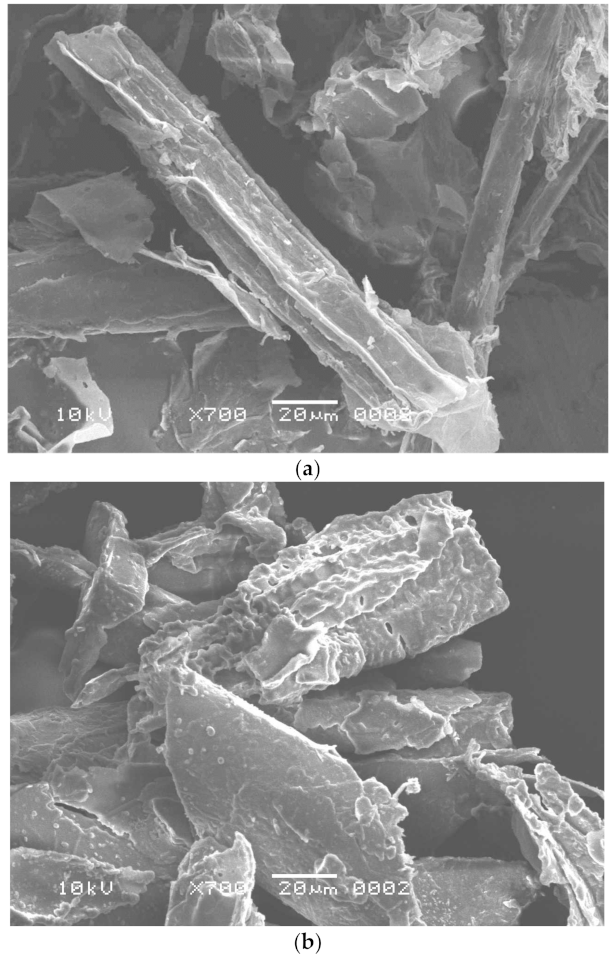
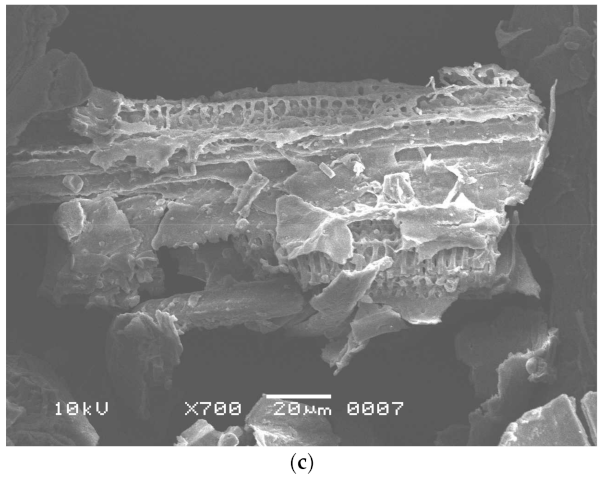
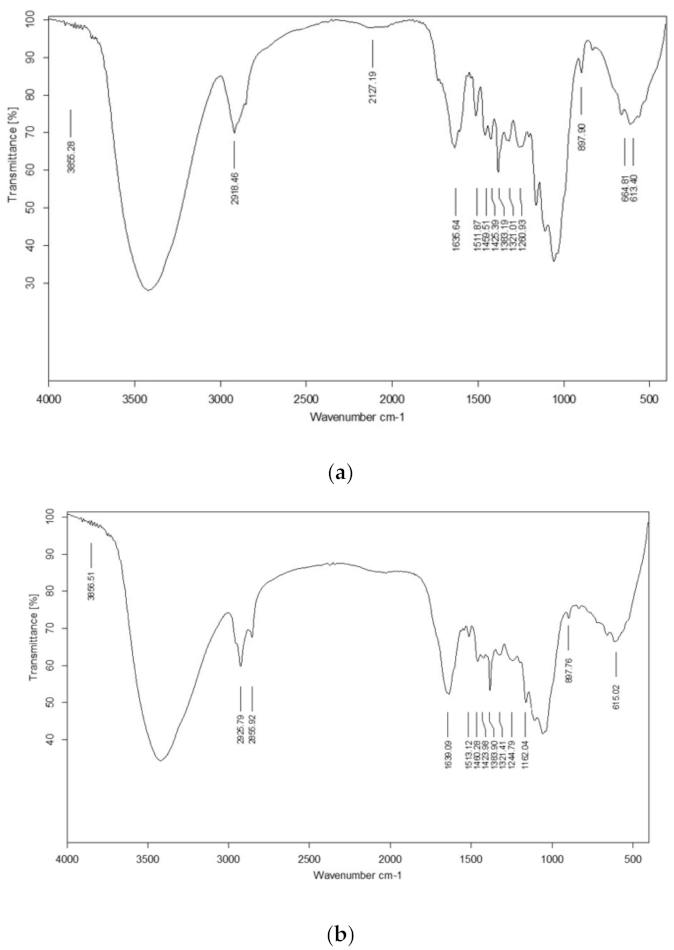

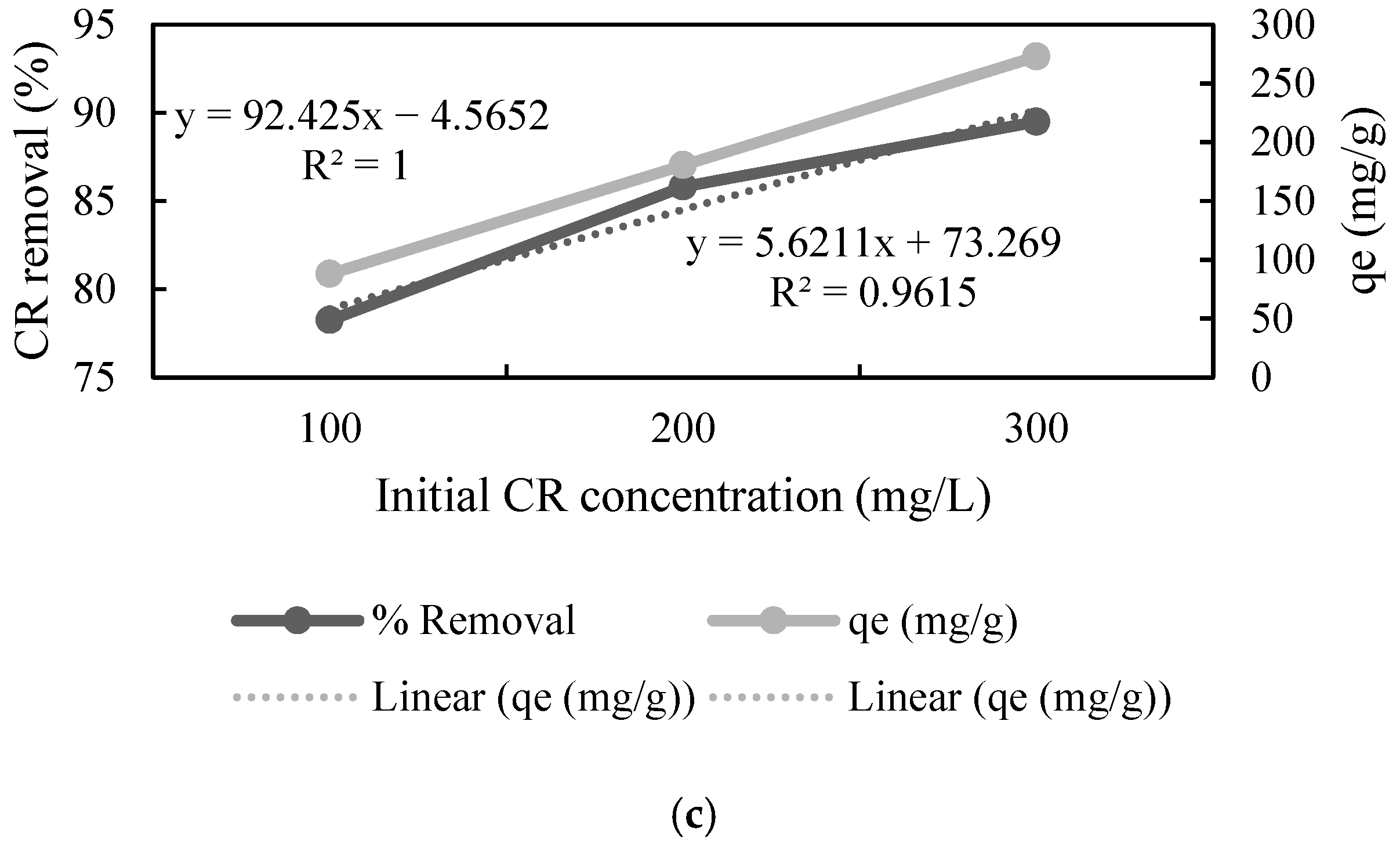
| Adsorbent | Freundlich | Langmuir | ||||
|---|---|---|---|---|---|---|
| KF a | N b | r2 c | KL d | qm (mg/g) e | r2 c | |
| UTB | 8.628 | 1.345 | 0.997 | 0.008 | 543.589 | 0.999 |
| PTB | 0.026 | 0.301 | 0.994 | −0.050 | −66.83 | 0.941 |
| FTB | 2.639 | 0.710 | 0.997 | −0.015 | −395.926 | 0.908 |
| Adsorbent | Adsorption Capacity (qe) (exp) (mg/g) | Pseudo-First Order | Pseudo-Second Order | ||||
|---|---|---|---|---|---|---|---|
| qe1 a | k1 b | r2 c | qe2 a | k2 b | r2 c | ||
| UTB | 0.12 | 0.032 | 0.159 | 0.833 | 0.126 | 6.649 | 0.999 |
| PTB | 0.138 | 0.048 | 0.604 | 0.965 | 0.141 | 27.951 | 0.999 |
| FTB | 0.142 | 0.008 | 0.224 | 0.999 | 0.143 | 53.312 | 1 |
| Adsorbent | kid a | I b |
|---|---|---|
| UTB | 0.007 | 0.086 |
| PTB | 0.006 | 0.116 |
| FTB | 0.001 | 0.136 |
| Adsorbent | Temperature (K) | CR Removal (%) | ΔG˚ (kJ/mol) a | ΔH˚ (kJ/mol) b | ΔS˚ (J/(mol K)) c |
|---|---|---|---|---|---|
| UTB | 303.15 | 90.363 | −5.641 | 10.18 | −15.38 |
| 308.15 | 88.528 | −5.235 | |||
| 318.15 | 88.324 | −5.352 | |||
| PTB | 303.15 | 98.358 | −10.315 | 102.46 | −303.41 |
| 308.15 | 97.338 | −9.222 | |||
| 318.15 | 90.091 | −5.839 | |||
| FTB | 303.15 | 97.701 | −9.45 | 68.2 | −194.99 |
| 308.15 | 95.006 | −7.547 | |||
| 318.15 | 91.722 | −6.362 |
Publisher’s Note: MDPI stays neutral with regard to jurisdictional claims in published maps and institutional affiliations. |
© 2021 by the authors. Licensee MDPI, Basel, Switzerland. This article is an open access article distributed under the terms and conditions of the Creative Commons Attribution (CC BY) license (https://creativecommons.org/licenses/by/4.0/).
Share and Cite
Ejaz, U.; Wasim, A.A.; Khan, M.N.; Alzahrani, O.M.; Mahmoud, S.F.; El-Bahy, Z.M.; Sohail, M. Use of Ionic Liquid Pretreated and Fermented Sugarcane Bagasse as an Adsorbent for Congo Red Removal. Polymers 2021, 13, 3943. https://doi.org/10.3390/polym13223943
Ejaz U, Wasim AA, Khan MN, Alzahrani OM, Mahmoud SF, El-Bahy ZM, Sohail M. Use of Ionic Liquid Pretreated and Fermented Sugarcane Bagasse as an Adsorbent for Congo Red Removal. Polymers. 2021; 13(22):3943. https://doi.org/10.3390/polym13223943
Chicago/Turabian StyleEjaz, Uroosa, Agha Arslan Wasim, Muhammad Nasiruddin Khan, Othman M. Alzahrani, Samy F. Mahmoud, Zeinhom M. El-Bahy, and Muhammad Sohail. 2021. "Use of Ionic Liquid Pretreated and Fermented Sugarcane Bagasse as an Adsorbent for Congo Red Removal" Polymers 13, no. 22: 3943. https://doi.org/10.3390/polym13223943
APA StyleEjaz, U., Wasim, A. A., Khan, M. N., Alzahrani, O. M., Mahmoud, S. F., El-Bahy, Z. M., & Sohail, M. (2021). Use of Ionic Liquid Pretreated and Fermented Sugarcane Bagasse as an Adsorbent for Congo Red Removal. Polymers, 13(22), 3943. https://doi.org/10.3390/polym13223943





